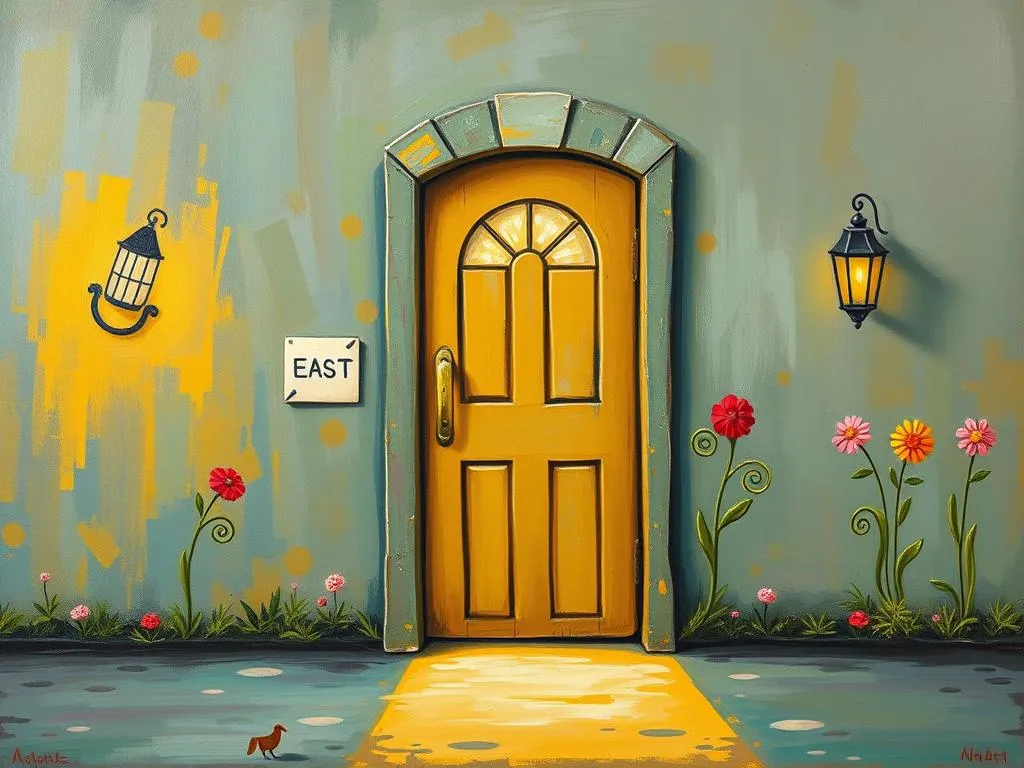
Have you ever found yourself standing before a door in a dream, feeling a mix of excitement and trepidation? The imagery of a door, particularly one facing the East, often carries profound meaning, beckoning us to explore the depths of our subconscious. Doors can symbolize opportunities, transitions, and even the thresholds of our lives. In many cultures, the East is associated with new beginnings—the rising sun heralding a fresh start. It’s a compelling metaphor for the changes we face in waking life, urging us to step through and embrace what lies ahead.
As we navigate the intricate symbolism of the East door, we’ll delve into its meanings across different cultures, explore scenarios that resonate with this theme, and reflect on how these interpretations can guide us toward personal growth. So, grab a cup of tea, settle in, and let’s unlock the secrets behind this powerful dream symbol together.
Opening the East Door: Symbolic Insights
When we think about the East, we often associate it with the dawn, renewal, and enlightenment. In many spiritual traditions, the East is revered as a sacred direction. For example, in Chinese philosophy, the East is linked to the element of wood and symbolizes growth and vitality. Similarly, in Native American cultures, the East represents the place of new beginnings and the promise of the day ahead.
In dream symbolism, a door often represents a choice or an opportunity that is presented to us. The East door, in particular, can signify that you are on the precipice of a new journey or a transformative experience. It encourages you to embrace change and seek out the possibilities that await you.
Additionally, the act of opening a door can symbolize discovery—not just of the external world but also of the self. This exploration into the unknown can lead to personal insights and a deeper understanding of one’s desires and aspirations. The East door invites you to confront your fears and embrace the unknown, suggesting that what lies ahead may be more rewarding than you anticipate.
Moreover, from a psychological perspective, the East door may represent the conscious mind confronting the unconscious. Carl Jung’s idea of the collective unconscious posits that dreams serve as a bridge, connecting us to universal themes and archetypes. The East door, therefore, could be an invitation to access hidden aspects of yourself and integrate them into your waking life.
Stepping Through: Scenarios That Speak
Dreams involving the East door can manifest in various ways, each with its nuances. Here are a few scenarios that might resonate, allowing you to reflect on your personal experiences:
-
The Hesitant Approach: You dream of standing before a grand East door, hesitant to turn the knob. As you look closer, you see light spilling through the cracks, illuminating the path ahead. This scenario may reflect your internal struggle with a decision or change in your life. The light symbolizes potential, urging you to overcome your reservations and embrace what awaits you.
-
The Open Door: In a different dream, you find the East door wide open, inviting you to step into a lush garden filled with vibrant flowers. This scenario suggests that you are ready to embrace new opportunities. The open door signifies that the universe is supporting your journey, encouraging you to walk through and explore the beauty of what’s to come.
-
The Locked Door: Imagine dreaming of a beautiful East door, but it’s locked tight. You feel frustration and longing as you rattle the handle. This dream may indicate that you are feeling blocked from a new opportunity or phase in your life. It might be a call to reflect on what barriers you’ve placed—whether they are self-imposed fears or external circumstances that need addressing.
-
The Doorway to the Sky: In a more surreal dream, you find yourself in front of an East door that opens to a sky filled with stars. As you step through, you feel weightless and empowered. This dream scenario represents the limitless possibilities that lie ahead. It encourages you to dream big and pursue your passions without restraint, reminding you that the universe is vast and full of potential.
-
The Shifting Door: You dream of a door that changes its appearance every time you approach it. Sometimes it’s ornate and inviting; at other times, it appears plain and unwelcoming. This scenario reflects the unpredictability of life’s opportunities. It suggests that you need to remain adaptable and open-minded, as the path to your goals may not always be straightforward.
In each of these scenarios, the East door serves as a symbolic gateway to your potential, inviting you to reflect on your feelings, desires, and fears associated with change. Each dream offers a unique perspective, ultimately guiding you toward a deeper understanding of your journey.
Embracing Change: The Path to Personal Growth
With the insights gained from the symbolism and scenarios surrounding the East door, how can you apply this understanding to foster personal growth? Here are some practical strategies to help you navigate the transitions in your life:
-
Embrace New Opportunities: Just as the East door symbolizes new beginnings, actively seek out opportunities in your waking life. Whether it’s starting a new job, pursuing a passion project, or engaging in a new relationship, give yourself permission to step through the door of possibility.
-
Reflect on Your Fears: If you find yourself hesitating at the threshold, take time to reflect on what is holding you back. Journaling can be a powerful tool for unpacking your fears and desires. Consider writing about what the East door means to you and what lies beyond it.
-
Cultivate a Growth Mindset: Embrace the idea that every experience—positive or negative—contributes to your growth. Look at challenges as opportunities for learning rather than obstacles. This mindset will empower you to approach life’s transitions with enthusiasm and resilience.
-
Practice Mindfulness: Spend time in meditation or mindfulness practices to connect with your inner self. This can help you tune into your intuition and recognize when it’s time to move through the East door. Being present can also help you appreciate the beauty of each moment, regardless of where you are on your journey.
-
Visualize Your Future: Create a vision board that represents your dreams and aspirations. Include images and words that inspire you and remind you of the potential that lies beyond the East door. Visualization can be a powerful motivator, helping you to focus your energy on what you want to achieve.
Incorporating these practices into your life can help you navigate change with confidence and grace, allowing you to embrace the new beginnings that the East door represents.
As we conclude our exploration of East door symbolism, remember that dreams are not merely reflections of our thoughts but powerful invitations to explore the depths of our being. Whether you find yourself standing before an open door or confronting a locked one, each moment offers a chance for growth and discovery.
Reflect on this: What opportunities are waiting for you beyond your East door? The answers may surprise you, guiding you toward a brighter, more fulfilling path. Embrace the journey, and don’t be afraid to step through the door when the moment calls. The world is waiting for you.







